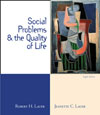CHAPTER 16 Population, Aging, and Urban Problems Population (pp. 544-552) Demography, the scientific study of population, produces knowledge that
is central to human well-being. For most of human history, the earth's population
increased rather slowly. Then, at the beginning of the Industrial Revolution
in the 18th century, population began a dramatic upward trend. The
crude birth rate is the number of births per year per thousand population. The
crude death rate is the number of deaths per year per thousand population. Migration
is the movement of people from one area to another. Migration is measured by
the immigration rate: the number of people who migrate to a nation in a year
per thousand population. Demographers refer to the demographic transition as
a shift from high rates of births and deaths to low rates of births and deaths.
Various problems result from population growth. There is a contradiction
between the growing population and the adequacy of such essentials as food,
water, housing, and jobs. Certain norms help maintain high birth rates. Some societies idealize or
romanticize large families, and these attitudes and values facilitate population
growth. One of the most important measures in reducing birth rates is to educate
women and bring them into the labor force. Aging (pp. 552-565) Because of lower death rates, including lower infant mortality rates, life
expectancy, the average number of years a newborn can expect to live, has gone
up throughout the world. The chronological age defined as the beginning point of being "old"
is arbitrary, a matter of societal norms. Both the number and the proportion
of the aged in the United States are increasing. Aging is both a biological and a social process. Senescence is biological
aging. Human life is a process, which means that there are new tasks for the
aged as well as for those who are younger. There is continuity in an individual's
life in that old age confronts the individual with developmental tasks and that
the elderly tend to think and behave and interact with others, much as they
did when they were younger. Aging also involves considerable diversity between
individuals. The aged are caught up in a number of contradictions that do not affect
people at earlier stages of life, including aloneness and loneliness, health
and satisfaction, the struggle for autonomy, institutionalization, elder neglect
and abuse, myths about the aged, and the right to die. There are three social structural factors that are involved in the problems
of aging: roles, norms, and social institutions. A number of attitudes and values
contribute to the problem of aging, including the fact that old age is a devalued
role. In addressing the problem of the aged, we must address the diversity of
the aged; the need of the elderly for autonomy, supportive relationships, and
meaningful activity; the need to provide care for those elderly who need help;
and the need for research on the chronic illnesses that afflict the elderly. Urbanization (pp. 565-572) The population is not only growing larger and older, it is also characterized
by urbanization: the increasing concentration of people living in cities. The world is an increasingly urban world: More than half the world's population
will live in urban areas by 2010. There are a number of problems associated with urbanization: urban sprawl,
housing, crowding and congestion, the environment, and poverty and urban decay.
Urban sprawl is the spread of an urban population over a large area. An increasing
number of Americans are unable to afford decent housing. Crowding and congestion
increase the stress of urban living. By their very nature, urban areas create
a number of environmental problems. Central cities are becoming progressively
impoverished. A number of economic factors and governmental policies have contributed
to various urban problems. A number of attitudes encouraged the flight to the
suburbs. Clearly, if urban problems are to be addressed effectively, there must
be both economic and governmental changes. Urban renewal efforts hold promise
for the future of urban areas. | 


 2002 McGraw-Hill Higher Education
2002 McGraw-Hill Higher Education